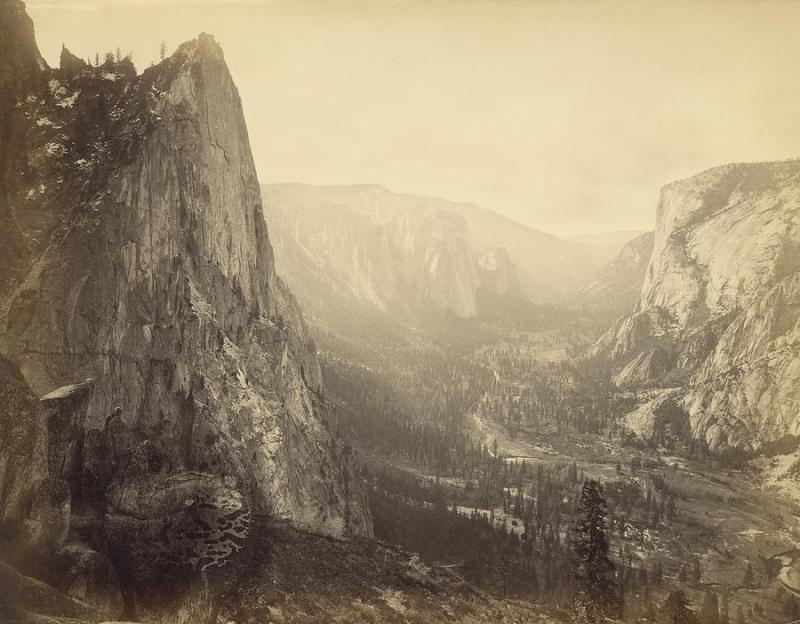Spirits of Silver
The Photography of Thomas Taylor
- Home
- Galleries

- A Little History
- Salt Print Gallery
- Black & White Gallery
- ... ..page 2
- Historical Processes: Albumin, Cyanotypes, Kallitypes, Uranotypes, and Van Dykes
- ..... Page 2
- Colorado Plateau Views
- Color Landscapes
- ..... .Page 2
- ...... Page 3
- ...... Page 4
- .......Page 5
- Urban Night Photography
- Urban Photography
- ...... Page 2
- WPA Murals San Francisco
- About
- News
- Contact
- Field Notes
- Purchase
- Blog

17 April 2022
About two weeks ago I drove to Yosemite which is about a 4 hour trip one-way from my home. It was the first time that I have been there since the start of the Pandemic. Although I brought two cameras with me, a 4x5 Toyo Robos monorail and an 8x10 Toyo MII field camera, photography wasn't the main reason for the trip. Last Spring I had ordered an REI Base Camp 4 tent while it was on sale, a new camp chair, a lantern to hang from the tents ceiling to read by, and a Sony boombox to play CD's. I even up-graded my trusty ¾ length Thermarest sleeping pad that I use for backpacking for a new full length “luxury” pad. I had grown tired of being confined to my Big Agnes 2-person tent and with my long distance backpacking days probably behind me I wanted a more comfortable “base camp” that would allow me to comfortably spend several days in one location for photography or observing with the telescope. With a 60 inch peak height and 60 sq foot floor area and good reviews, it seemed the perfect choice. I can position a table and chair easily inside and could probably position the the telescope (a 10” Schmidt Cassegrain) in the vestibule area. The Base Camp 6 has a 74 inch peak height and an 81 sq ft floor area but I thought that it was too big for me to handle alone and I don't really need to stand upright in the tent. Here is a picture of it setup in Upper Pines campground on the 2d day of the trip:

Although the camping experience was positive the Yosemite experience wasn't. The valley appeared to be trashed by a smoldering prescribed burn on both sides of the road from the Pohono Bridge to near Sentinel Beach. I've never see such devastation from a prescribed burn before and was truly shocked as I drove through it. I think that the Park Service is trying to implement the forest control burn practices of the native Americans to reduce the possibilities of a catastrophic wildfire and to create a more “park like” atmosphere.
Early photographs of the Valley taken in the 1850's and 1860's reveal that there were fewer trees and more open spaces in the valley than there are today. For example, this image of the Valley attributed to Carleton Watkins and taken around 1870 from the Union Point area, shows that there were far fewer trees and more open spaces in the valley back then there is today:

The native inhabitants of the Valley, the Ahwahnechee, whose main village was located in the Yosemite Falls area, regularly preformed controlled burns to control the undergrowth and maintain the oak population. That the park service is attempting to bring back that atmosphere is commendable but it will probably take several years if not decades to complete. In the meantime the valley will continue exhibit a “trashed” appearance in many spots.
While photography wasn't the main reason for the trip, it nevertheless provided a good image of Cascade Falls with a 480mm apo-Ronar lens on the Robos. I plan on returning, hopefully this season, to shoot a 5x7 negative of the falls with the 760mm apo-Nikkor lens for an alternative print.

Copyright 2007 - 2023 Thomas Taylor. All rights reserved. No part of this site may be reproduced, stored in a retrieval system, or transmitted in any form or by any means - electronic, mechanical, photocopying, recording or otherwise, without the written permission of the copyright owner.